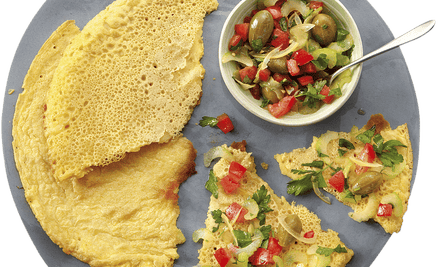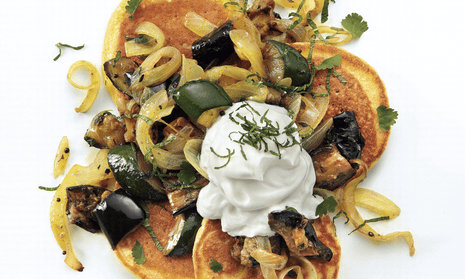For something so small and beige, the chickpea certainly elicits strong feelings. For those of us who cook with it, the variables in the making of hummus and falafel, say, can be a hot topic. But the chickpea is also an unlikely source of poetic inspiration. If you’re ever at a pub quiz and faced with the (unlikely) question as to what Hans Christian Anderson, Madhur Jaffrey and the 13th-century Sufi mystic and poet Rumi have in common, let me tell you that they all harnessed the chickpea to great effect in their writing.
Andersen’s fairytale The Princess And The Pea (I will assume, for the sake of my argument, that he meant a chickpea) and Rumi’s poem The Chickpea use the little pea to address unexpectedly weighty matters. How could something so tiny create so much turmoil and disturb the princess’s sensibility so much? Why is suffering necessary before Rumi’s chickpea can be transformed into something great? Or, as the chickpea, leaping out of the flame, asks the cook, “Why do you set fire to me? You chose me, bought me, brought me home – for this?”
Leaving such lofty discussions about the human condition to the poets, the chickpea is something I feel passionate about as a cook, whatever stage it is at in its life – whole, crushed, blitzed or ground; soaked, cooked, dried or tinned. I rely on chickpeas in their whole form a great deal, but it’s when the are dried and ground to make chickpea flour (also known as Bengal gram, gram flour and besan flour) that they make some of my favourite comfort food. Iranian gondi dumplings served in an aromatic broth; light and fluffy “pudlas”, or pancakes; thin batter for pakora-style prawn or vegetable fritters; Italian flatbreads; and cardamom- and rosewater-scented biscuits studded with pistachios: the principal ingredient in all of these is the pale yellow and slightly nutty-tasting gram flour.
Gram flour also spreads its comforting embrace through soups and warm yoghurt sauces, where it helps to thicken and prevent curdling; and in innumerable Indian sweet and savoury treats, from sev (a crisp, vermicelli-like street snack) to besan barfee (a sweet gram flour fudge studded with pistachios and almonds).
And where does Madhur Jaffrey fit into all this? Well, it’s her paean to gram flour in Eastern Vegetarian Cooking that got me started on this line of thought in the first place. She writes that just “one bowl of rice topped with some karhis [an Indian soup-like dish made with yogurt or buttermilk thickened with gram flour], and I begin to purr”. The pulse rate gets raised by the pulse. Now that’s poetry.
Chickpea pancakes
The next two recipes – the pancakes and spiced aubergine – are intended to be served together, but if you choose just to make the pancakes, serve them with some yoghurt and your favourite savoury chilli sauce. Gram flour absorbs a lot of moisture, so these are to be eaten fresh out of the pan, when they are at their height of lightness and fluffiness. Makes 12 pancakes, to serve four.
100g gram flour
½ sachet fast action yeast (4g)
½ tsp caster sugar
Salt
1 small (or ½ large) egg, beaten
½ tsp baking powder
Vegetable oil, for frying
Put the flour, yeast and sugar in a large bowl with a quarter-teaspoon of salt. Add the egg and 100ml water, and whisk until smooth. Cover with clingfilm and set aside for an hour, until doubled in size. Add the baking powder, mix well and set aside for 10 minutes longer.
Put a heavy-bottomed skillet pan on a medium heat and add a tablespoon of oil. Once hot, put three or four heaped dessertspoons of the batter into the pan, and cook for four minutes in total, turning once halfway through, until the pancakes have risen to about 1.5cm in height and are light, fluffy and golden-brown. Transfer to a wire rack and set aside while you cook the remaining batter mixture, adding more oil with each batch. Serve at once, with the following spiced aubergine alongside.
Spiced aubergine and courgette
This is the perfect thing to scoop up with your chickpea pancakes, but it also works brilliantly as a condiment with all sorts of other dishes: plain steamed rice, grilled meat or fish, spread on toasted sourdough – you really can’t go wrong. Serves four.
2 medium aubergines, trimmed and cut into 2cm dice
2 medium courgettes, trimmed and cut into 2cm dice
Salt
140ml vegetable oil
2 medium onions, peeled and cut into 1cm slices
½ tsp ground turmeric
¼ tsp ground cloves
½ tsp ground cinnamon
1 tbsp black mustard seeds
1 tsp cider vinegar
10g coriander leaves, roughly chopped
5g mint leaves, roughly chopped
80g Greek yoghurt, to serve
Put the aubergine and courgette in a large colander with a teaspoon of salt, mix well to coat the veg and leave over a sink or bowl for an hour, to drain. Pat dry with a clean tea towel and set aside.
Pour the oil into a large saute pan and place on a medium-high heat. Once hot, add the onions and fry for five minutes, stirring often, until beginning to turn golden-brown, then use a slotted spoon to transfer to a large bowl.
Add the vegetables to the hot pan (depending on the size of your pan, you may need to fry them in batches), and stir in the turmeric, cloves, cinnamon, mustard seeds and half a teaspoon of salt. Fry for 15 minutes, stirring frequently, until the aubergine and courgette have taken on a lot of colour, then transfer to the onion bowl. Stir through the vinegar and herbs, and serve warm or at room temperature, with a spoonful of yoghurt alongside.
Farinata with celery and caper salsa

These moreish Italian flatbreads are quite large, so each can serve two. Cut them up to serve on separate plates, or pile up the two farinata on one plate for people to pull at and spoon the salsa on top as they go. Or serve pre-dinner with drinks and without the salsa. For four.
200g gram flour (aka chickpea flour)
60ml olive oil
Salt
For the salsa
3 medium celery sticks, very finely sliced
15g parsley, roughly chopped
3 tbsp caper berries, stalks removed (or use normal capers if need be)
½ large preserved lemon, flesh discarded and skin finely chopped
2 medium tomatoes, cut into 1cm dice
2 tbsp olive oil
1 tbsp lemon juice
Put the gram flour in a large bowl and, whisking constantly, slowly add 450ml water until well combined. Set the batter aside for 20 minutes.
Meanwhile, put all the salsa ingredients in a bowl, stir, add a pinch of salt if it needs it and set aside.
Heat the oven to 220C/425F/gas mark 7. Whisk two tablespoons of the olive oil into the batter, then stir in a teaspoon of salt. Put a heavy-based, oven-proof, 25cm skillet pan on a high heat with a tablespoon of oil. Once the oil starts to smoke, pour in half the batter: it should be about 4mm thick. Leave on the heat for 30 seconds, until it starts to bubble, and then transfer the pan to the oven for 10 minutes, until the farinata is cooked through. It should be browned and crisp on both sides, but soft in the middle. Remove from the oven and, using a spatula, transfer the farinata to a plate. Keep warm while you cook the second farinata with the remaining oil and batter. Serve at once, with the salsa spooned alongside or on top.
Yotam Ottolenghi is chef/patron of Ottolenghi and Nopi in London.
Follow Yotam on Twitter.

Comments (…)
Sign in or create your Guardian account to join the discussion